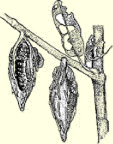 |
The Bay Gardener
By Dr. Frank Gouin
|
Attack Bagworms Early
Wait much longer, and you’ll have to bring in the big guns
If you have pine trees, junipers, arbor vitae or thuja, spruce, fir or false cypress plants growing in your landscape, look them over carefully for bagworms. If you had bagworms last year, you will certainly have them again this year. At this time of year they are between one-half to one inch long and can be seen dangling at the tips of branches or needles.
If there are only a few, it is best to hand pick them and throw them on the ground. It is impossible for them to crawl back up into the plant. By throwing them on the ground, you encourage natural predators into your landscape, helping control bagworms next year. The natural predators that feed on bagworms must have bagworms to feed on. If you want to see how many you have collected, spread your collection on the ground beneath one of the plants you collected from. You’ll provide a feast for natural predators, who will hang around to feast on next year’s brood.
However, if your plants are heavily infested with bagworms now, the only sure method of control is by spraying them with an insecticide. Until the bagworms are approximately three-quarters of an inch long, they can be controlled by using environmentally friendly products such as BT or Dipel. These are bacillus bacteria that feed and digest the larvae within the bag. However, they can only function on young larvae.
Always use fresh BT or Dipel because these pesticides lose their potency within a few months after opening. For most home gardeners, it is best to purchase only small amounts and discard them at the end of the season. BT and Dipel are also effective against other insects such as cabbage loopers, eastern-tent caterpillar and the caterpillars that attack parsley, dill and fennel.
As the bagworms grow older, they become resistant to BT or Dipel. To control bagworms that are one inch or longer, you must use one of the hard insecticides, Sevin.
If you need to use Sevin to kill the bagworms, apply it early in the morning, when the bagworms are most susceptible. It should be used with care and never on plants that are in flower. Sevin is known to kill honey bees that carry it back to their hives.
Ask Dr. Gouin your questions at [email protected]. All questions will appear in Bay Weekly. Please include your name and address.